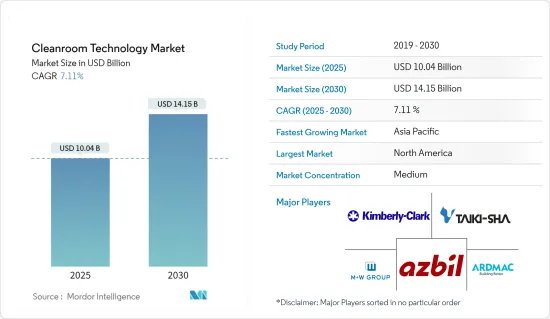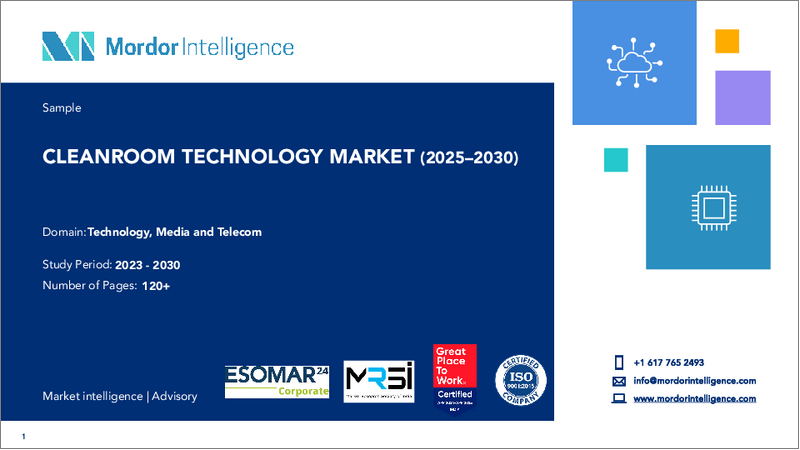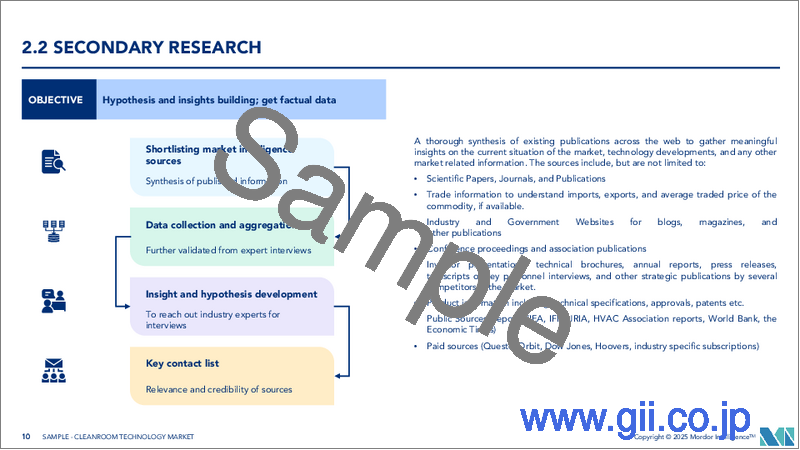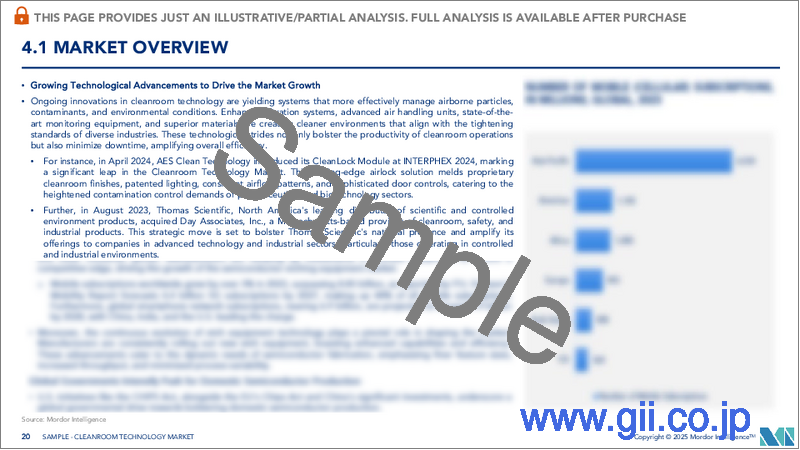|
|
市場調査レポート
商品コード
1687188
クリーンルーム技術:市場シェア分析、産業動向・統計、成長予測(2025年~2030年)Cleanroom Technology - Market Share Analysis, Industry Trends & Statistics, Growth Forecasts (2025 - 2030) |
||||||
カスタマイズ可能
適宜更新あり
|
|||||||
| クリーンルーム技術:市場シェア分析、産業動向・統計、成長予測(2025年~2030年) |
|
出版日: 2025年03月18日
発行: Mordor Intelligence
ページ情報: 英文 129 Pages
納期: 2~3営業日
|
- 全表示
- 概要
- 目次
クリーンルーム技術市場規模は2025年に100億4,000万米ドルと推定され、予測期間中(2025~2030年)のCAGRは7.11%で、2030年には141億5,000万米ドルに達すると予測されます。

主要ハイライト
- 品質と安全基準の進化と厳格化に伴い、クリーンルーム技術への需要が高まっています。クリーンルームは、空気の質、微粒子レベル、温度、湿度を精密に調整し、制御された環境を記載しています。クリーンルームは、空気中の微粒子、微生物、製品の完全性に悪影響を与えるその他の汚染物質による汚染リスクを最小限に抑えます。製薬、バイオテクノロジー、エレクトロニクスなどの産業では、規制機関が課す厳格な品質・安全要件を満たすためにクリーンルームを利用しています。品質と安全基準への注目が高まるにつれ、重要な製品の品質と安全基準を維持・確保するためのクリーンルーム技術の採用が推進されています。
- 近代的なクリーンルームの開発は、第二次世界大戦中に戦車、銃、航空機の製造に使用される計測機器の品質と信頼性を高めるために始まりました。この時期、核分裂の実験や化学・生物戦の研究から生じる危険な放射性物質、微生物、化学汚染物質を封じ込めるためにHEPAフィルターも開発されました。クリーンルームの進化は、1950年代と1960年代のNASAの宇宙旅行計画によって勢いを増しました。この時期に「層流」の概念が導入され、クリーンルーム技術の転換点となりました。
- エレクトロニクスの需要拡大に伴い、クリーンルーム技術プロバイダーはビジネスの拡大を目の当たりにしています。その結果、先進国や発展途上国の政府は、国内でのあらゆる乏しい状況に対応できる十分なクリーンルームの確保に大きく取り組んでいます。例えば、米国政府は前年にCHIPS法を正式に可決しました。この法律では、米国企業が半導体製造のクリーンルームを海外のクリーンルームにアウトソーシングするのではなく、米国内に建設することを求めています。この法律の導入後、海外の半導体メーカーも米国政府の資金を得るために、米国に新たなクリーンルームを建設する計画を立てています。
- 2024年4月、バイデン大統領はCHIPS and Science Actに基づき、マイクロンと最大61億米ドルの予備合意を発表しました。この投資は、ニューヨーク州クレイに2つのファブ、アイダホ州に1つのファブの建設を支援し、2030年までに500億米ドルの民間投資を放出するもので、今後20年間で両州に最大1,250億米ドルを投資し、最先端のメモリー製造エコシステムを構築するというマイクロン社の投資の第一歩となります。今回の資金調達は、最先端のDRAMチップ生産に特化した4ファブ「メガファン」計画のうち、最初の2ファブの建設を支援します。各ファブには60万平方フィートのクリーンルームが設置され、4施設合計で240万平方フィートのクリーンルーム・スペースが確保されます。これは米国でこれまで発表された中で最も広大なクリーンルーム・スペースであり、サッカー場40面分に相当します。
- 医療機器に対する需要の高まりと製薬産業における研究開発費の増加が、市場の成長をさらに後押ししています。IQVIAによると、世界の医薬品市場は近年著しい成長を遂げています。2023年、世界の医薬品市場規模は約1兆6,000億米ドルに達します。これは前年と比較して1,000億米ドル以上の増加です。
- 品質と安全性の基準が進化し、より厳しくなるにつれて、クリーンルーム技術への需要が高まっています。クリーンルームは、空気の質、微粒子レベル、温度、湿度を正確に調整し、制御された環境を記載しています。クリーンルームは、空気中の微粒子、微生物、製品の完全性に悪影響を与えるその他の汚染物質による汚染のリスクを最小限に抑えます。製薬、バイオテクノロジー、エレクトロニクスなどの産業では、規制機関が課す厳格な品質・安全要件を満たすためにクリーンルームを利用しています。品質と安全基準への注目が高まるにつれ、重要な製品の品質と安全基準を維持・確保するためのクリーンルーム技術の採用が推進されています。
- 例えば、2023年8月、Boschはマレーシアにチップとセンサのための最先端の半導体テストセンターを設立する計画を発表しました。この施設は1万8,000平方メートルを超える広大な敷地を誇り、クリーンルーム、オフィススペース、研究開発専用ラボを備え、最大400人の従業員を収容できます。
- クリーンルームは、高品質な製品を維持するために管理された環境が必要なことから、さまざまなエンドユーザー市場で人気を集めています。しかし、クリーンルームのコストは、建設に多大な投資がかかるだけでなく、運用コストも必要な空気交換の回数や濾過効率に左右されます。
- 適切な大気質を維持するためには、クリーンルームを常時稼働させなければならないため、運用コストは非常に高くなります。エネルギー効率の高い運用とクリーンルーム基準の継続的な遵守により、クリーンルームは製造技術やラボにとって最も重要インフラのひとつとなっています。このことは、市場の成長の課題になると予想されます。
クリーンルーム技術市場の動向
市場成長を大きく牽引する半導体製造エンドユーザー
- クリーンルームは半導体製造に必要であり、この産業は繊細なマイクロエレクトロニクスを製造するためにクリーンルーム環境に大きく依存しています。半導体チップは、携帯電話のような家庭用品から、自動車、防衛技術、宇宙船のような複雑な機械に至るまで、あらゆるコンピュータ化された機器に利用されています。半導体チップは、影響を受けやすい材料を使用して製造され、慎重に作業しなければならない繊細な層を形成します。そのため、半導体チップの製造、包装、テストなどの作業は、管理されたクリーンルーム環境で行わなければなりません。
- 半導体クリーンルームは、最も要求の厳しいクリーンルームのひとつです。フォトリソグラフィーの線幅が0.1ミクロン以下になるため、これらのクリーンルームは通常、クラス10または100のクリーンルーム分類(ISO-4またはISO-5)となります。さらに、半導体クリーンルームには厳しい温度と湿度の要件があります。このようなクリーンルームの大きさは500SFから500,000SFまで様々です。通常、半導体クリーンルームではHEPAフィルターの代わりにULPAフィルターを使用し、最小のサブミクロン粒子のクリーンルームへの侵入を防ぎます。HEPAフィルターが0.3uで99.97%の粒子を捕集できるのに対し、ULPAフィルターは0.12uで99.999%の粒子を捕集できます。
- 例えば、2023年6月、世界有数の半導体企業であるMicron Technology Inc.は、インドのグジャラート州に独自の組立・検査施設を建設する計画を発表しました。Micronの新施設はDRAMとNAND製品の組立とテスト製造を可能にし、国内外市場の需要に対応します。
- 世界の半導体産業への投資の拡大は、市場の主要な成長促進要因です。例えば、Analog Devices Inc.は2023年7月、製造を最適化するためにクリーンルーム機能を強化する意向を発表しました。同社は最新の投資の一環として、半導体メンテナンス・トレーニングプログラムを導入します。この10億米ドルの大規模な投資は、ビーバートンの半導体施設の成長と効率性を促進する態勢を整えています。特筆すべきは、この拡大により25,000平方フィートが追加され、クリーンルームの収容能力が11万8,000平方フィートという驚異的な規模になることです。
- 最近、モーガン州立大学は、半導体の設計と製造におけるイノベーションを創出・推進し、公立学校教育が直面する課題に対処する2つの最新研究センターの立ち上げを支援するため、680万米ドルの追加州資金を確保しました。
- 5Gネットワークの拡大、モノのインターネット(IoT)機器の普及、人工知能(AI)や機械学習(ML)アプリケーションの成長といった動向に牽引されて半導体の需要が高まる中、半導体メーカーは生産能力を増強する必要があります。この生産能力増強には、半導体製造に必要な厳しい清浄度基準を満たす最新のクリーンルーム技術を備えたクリーンルーム施設の建設や拡大が必要です。WSTSによると、2024年の半導体売上高は全世界で5,883億6,000万米ドルに達し、前年を大幅に上回ると予想されています。
- 全体として、半導体需要の増大は、半導体製造能力の拡大をサポートし、様々な産業や用途向けの高品質チップの生産を保証するために、クリーンルーム技術への投資を促進します。
北米が大きな市場シェアを占める見込み
- 北米は、主にクリーンルームの技術的進歩、同地域の医療セクターの成長、製品認可のための厳しい規制基準がこの市場開拓を推進する要因であることから、予測期間中に大きな成長を遂げると予測されています。CMSによると、米国の国民医療費総額は2024年度に4兆8,000億米ドルを記録し、2031年には7兆1,000億米ドルに達すると予測されています。
- アフターマーケットの売上増加や、切断から長さへの変更伐採技術へのシフトも市場成長に寄与しています。この成長は、特に自動車、化学、鉄鋼産業と比較してまだ若いバイオテクノロジー産業が成長していることが主因です。バイオテクノロジー産業の開発はユニークな物語であるが、アメリカの他の産業セグメントに共通する基盤の上に成り立っています。NIHによると、2023会計年度のNIHによるバイオテクノロジー資金は約89億米ドルでした。さらに、2024年度には91億米ドルに達すると推定されています。
- 政府出資、民間出資を問わず、長年にわたる調査は、世界でも類を見ない知識ベースを提供し続けています。バイオマニュファクチャリングを通じて、米国内のサステイナブルバイオマスは新製品に変換され、化学品、医薬品、燃料、材料などの石油ベースの生産に代わるものを提供しています。
- 例えば、Financial Times US Pharma and Biotechは2024年5月にニューヨークで開催され、エンドポインツ・ニュースと初めて提携しました。このイベントでは、バイオファーマのリーダー、規制当局、投資家、科学者が一堂に会し、今後1年に関する独自洞察を共有し、産業や国に影響を与える最も重要な動向について議論しました。こうした取り組みが、この地域の市場需要をさらに押し上げる可能性があります。
- 2024年4月、Amgenはオハイオ州ニューオールバニーに新しいAI対応バイオ製造施設を開設しました。およそ400人を雇用する予定です。3億6,500万米ドルを投資したこの施設は、自動化、AI、データ駆動型の製造プロセスを特徴とし、リアルタイムのパフォーマンスを最適化します。この施設は環境持続可能性基準に基づいて建設され、Amgenのカーボンニュートラル目標をサポートしています。
- この地域諸国は主にチップ製造の強化に期待しており、AI、5G、量子コンピューティングなど、今後数十年の世界経済と軍事的リーダーシップを左右する将来の戦略的技術でアメリカを支援することが期待されています。半導体産業協会の新しいレポートによると、米国政府は、米国におけるチップ製造の減少という数十年にわたる軌跡を逆転させ、国家安全保障を強化し、サプライチェーンをより強靭にし、米国を半導体製造に世界で最も魅力的な場所の一つにする戦略的機会を手にしています。各社が今後数年間でこの地域を主要化する計画を発表していることから、この成長は北米クリーンルーム技術市場に大きな牽引力をもたらすと期待されています。
クリーンルーム技術市場概要
クリーンルーム技術市場では、クリーンルーム機器産業の細分化により競争企業間の激しい敵対関係が蔓延しており、多数のベンダーが市場シェアを争っています。特に消耗品セグメントでは、市場の大部分を獲得しようとするベンダーの間で激しい競争が繰り広げられています。このセグメントの主要企業には、M+W Group GmbH、Azbil Corporation、Taikisha Global Limited、Kimberly Clark Corporation、Ardmac Ltd.などがあります。
2024年4月、AES Clean Technologyは、2024年 4月16日のINTERPHEX 2024でCleanLock Moduleの発売を発表しました。クリーンルーム用のエアロックソリューションは、AES独自のクリーンルーム仕上げ、特許取得済みの照明、予測可能な気流パターン、先進的ドア制御を統合することにより、汚染リスクを最小限に抑えるように設計されています。これらの機能は、どのような施設にも遅滞なく組み込むことができます。CleanLockモジュールは、既存のクリーンルームに入る人や物質の安全な移行を可能にします。
2024年2月、Analog Devices Inc.は、世界有数の半導体専業鋳造メーカーであるTSMCと特別な取り決めを行い、熊本県にあるTSMCの過半数出資製造子会社であるJapan Advanced Semiconductor Manufacturing Inc.(JASM)を通じてウエハー生産能力を長期的に供給すると発表しました。
その他の特典
- エクセル形式の市場予測(ME)シート
- 3ヶ月間のアナリストサポート
目次
第1章 イントロダクション
- 調査の前提条件と市場定義
- 調査範囲
第2章 調査手法
第3章 エグゼクティブサマリー
第4章 市場洞察
- 市場概要
- 産業の魅力-ポーターのファイブフォース分析
- 供給企業の交渉力
- 買い手の交渉力
- 新規参入業者の脅威
- 代替品の脅威
- 競合の程度
- 主要マクロ経済動向が市場に与える影響
第5章 市場力学
- 市場促進要因
- 主要市場におけるバイオテクノロジーと医療支出の全体的成長
- 厳しい政府規制と高品質製品に対する需要
- 市場課題
- 高い設置費用、メンテナンス費用、熟練労働者の不足
第6章 市場セグメンテーション
- コンポーネント別
- 機器タイプ
- クリーンルーム用エアシャワー
- HVACシステム
- 層流システム
- 高効率フィルター
- デシケーターキャビネット
- ファンフィルターユニット
- 消耗品タイプ
- 衣類
- 手袋
- ワイプ
- 真空システム
- 消毒剤
- その他の消耗品
- 機器タイプ
- エンドユーザー別
- 製薬
- バイオテクノロジー
- 医療機器
- 病院
- 半導体製造
- その他
- 地域別
- 北米
- 欧州
- アジア
- オーストラリア・ニュージーランド
- ラテンアメリカ
- 中東・アフリカ
第7章 競合情勢
- 企業プロファイル
- M+W Group
- Azbil Corporation
- Taikisha Global Limited
- Kimberly Clark Corporation
- Ardmac Ltd
- Ansell Limited
- Clean Air Products
- Labconco Corporation
第8章 投資分析
第9章 市場の将来
The Cleanroom Technology Market size is estimated at USD 10.04 billion in 2025, and is expected to reach USD 14.15 billion by 2030, at a CAGR of 7.11% during the forecast period (2025-2030).

Key Highlights
- The demand for cleanroom technology grows as quality and safety standards evolve and become more stringent. Cleanrooms offer controlled environments with precise regulation of air quality, particulate levels, temperature, and humidity. They minimize the risk of contamination from airborne particles, microorganisms, and other contaminants that can adversely affect product integrity. Industries such as pharmaceuticals, biotechnology, and electronics rely on cleanrooms to meet the strict quality and safety requirements imposed by regulatory bodies. The increasing focus on quality and safety standards drives the adoption of cleanroom technology to maintain and ensure significant product quality and safety standards.
- The modern, clean room development began during the Second World War to enhance the quality and reliability of instrumentation used in manufacturing tanks, guns, and aircraft. During this time, HEPA filters were also developed to contain the dangerous radioactive, microbial, or chemical contaminants that resulted from experiments into nuclear fission and research into chemical and biological warfare. The evolution of clean rooms gained momentum due to NASA's space travel program in the 1950s and 1960s. During this time, the 'laminar flow' concept was introduced, marking a turning point in clean room technology.
- With the growing demand for electronics, cleanroom technology providers are witnessing increased business. As a result of this, governments from developed and developing nations are significantly working toward securing ample cleanrooms to handle any scarce situation domestically. For instance, the US government officially passed the CHIPS Act in the previous year. Under this act, the US government wanted US companies to build cleanrooms in the United States for semiconductor manufacturing instead of outsourcing to cleanrooms in foreign countries. After introducing this act, foreign semiconductor manufacturers have also been planning new US-based cleanrooms to get US government funding.
- In April 2024, President Biden announced up to USD 6.1 billion preliminary agreement with Micron under the CHIPS and Science Act. This investment will support the construction of two fabs in Clay, New York, and one fab in Idaho, releasing USD 50 billion in private investment by 2030 as the first step toward Micron's investment of up to USD 125 billion across both states over the next two decades to create a leading-edge memory manufacturing ecosystem. Funding will support the construction of the first two fabs of a planned four-fab "megafan" focused on leading-edge DRAM chip production. Each fab will have 600,000 square feet of cleanrooms, totaling 2.4 million square feet of cleanroom space across the four facilities, the most extensive cleanroom space ever announced in the United States and the size of nearly 40 football fields.
- Growing demand for medical instruments and increasing R&D spending in the pharmaceutical industry further propel the market growth. According to IQVIA, the global pharmaceutical market has experienced significant growth in recent years. In 2023, the total global pharmaceutical market was around USD 1.6 trillion. This is an increase of over USD 100 billion compared to the previous year.
- The demand for cleanroom technology grows as quality and safety standards evolve and become more stringent. Cleanrooms offer controlled environments with precise regulation of air quality, particulate levels, temperature, and humidity. They minimize the risk of contamination from airborne particles, microorganisms, and other contaminants that can adversely affect product integrity. Industries such as pharmaceuticals, biotechnology, and electronics rely on cleanrooms to meet the strict quality and safety requirements imposed by regulatory bodies. The increasing focus on quality and safety standards drives the adoption of cleanroom technology to maintain and ensure significant product quality and safety standards.
- For instance, in August 2023, Bosch announced plans to establish a state-of-the-art semiconductor test center for chips and sensors in Malaysia. The facility boasts an expansive area of over 18,000 square meters, housing clean rooms, office spaces, and dedicated R&D laboratories to accommodate up to 400 associates.
- Cleanrooms are gaining popularity in various end-user markets as a controlled environment is necessary for maintaining high-quality products. However, the cost of a cleanroom is not only highly investment-intensive to build, but operational costs can also rely on the number of required air exchanges and filtration efficiency.
- The operation can be extremely costly, as holding the appropriate air quality means the room has to be in constant operation. Energy-efficient operation and continuous adherence to cleanroom standards make a cleanroom one of the most critical infrastructures for manufacturing technology and laboratories. This is anticipated to challenge the market's growth.
Cleanroom Technology Market Trends
Semiconductor Manufacturing End User Significantly Driving the Market Growth
- Cleanrooms are necessary for semiconductor manufacturing as this industry relies heavily on cleanroom environments to manufacture sensitive microelectronics. Semiconductor chips are utilized in every computerized device, from household objects like cell phones to complex machines such as vehicles, defense technology, or spacecraft. They are produced using susceptible materials to create delicate layers that must be worked on carefully. Thus, tasks like semiconductor chip manufacturing, packaging, and testing must be carried out in a controlled cleanroom environment.
- Semiconductor cleanrooms are among the most demanding cleanrooms. As photolithography linewidths go below 0.1 microns, these cleanrooms are usually class 10 or 100 cleanroom classification (ISO-4 or ISO-5). Additionally, semiconductor cleanrooms have tight temperature and humidity requirements. Such cleanrooms can vary in size from 500 SF to 500,000 SF; usually, semiconductor cleanrooms use ULPA filters instead of HEPA filters to prevent even the smallest submicron particles from entering the cleanroom. While HEPA filters can catch 99.97% of particles at 0.3u, ULPA filters can catch 99.999% at 0.12u.
- For instance, in June 2023, Micron Technology Inc., one of the world's significant semiconductor companies, announced plans to build a unique assembly and test facility in Gujarat, India. Micron's new facility will allow assembly and test manufacturing for DRAM and NAND products and address demand from domestic and international markets.
- The growing investments in the semiconductor industry worldwide are a key growth driver for the market. For instance, in July 2023, Analog Devices Inc. announced its intention to enhance its cleanroom capabilities to optimize manufacturing. The company will introduce a semiconductor maintenance training program as part of its latest investment. This substantial investment of USD 1 billion is poised to foster the growth and efficiency of the semiconductor facility in Beaverton. Notably, the expansion will result in an additional 25,000 square feet, boosting the cleanroom capacity to an impressive 118,000 square feet.
- Recently, Morgan State University secured an additional USD 6.8 million in state funding to support the launch of two latest research centers that will create and drive innovation in the design and fabrication of semiconductors and handle the challenges facing public school education.
- As the demand for semiconductors rises, driven by trends such as the expansion of 5G networks, the proliferation of Internet of Things (IoT) devices, and the growth of artificial intelligence (AI) and machine learning (ML) applications, semiconductor manufacturers need to ramp up production capacity. This increased production capacity requires constructing or expanding cleanroom facilities equipped with the latest cleanroom technology to meet the stringent cleanliness standards necessary for semiconductor fabrication. According to WSTS, 2024 semiconductor sales were expected to reach USD 588.36 billion worldwide, significantly more than the previous year.
- Overall, the growing demand for semiconductors drives investment in cleanroom technology to support the expansion of semiconductor manufacturing capacity and ensure the production of high-quality chips for various industries and applications.
North America is Expected to Hold Significant Market Share
- It is anticipated that North America will experience significant growth during the forecast period, primarily due to the technological advancements in cleanrooms, the growth of the healthcare sector in the region, and stringent regulatory standards for product approvals are the factors propelling the development of this market. According to CMS, the total US national health expenditure recorded was USD 4.8 trillion in FY 2024, and it is projected to reach USD 7.1 trillion by 2031.
- Rising aftermarket sales and the shift toward modified cut-to-length logging techniques also contribute to the market growth. This growth is primarily attributed to the growing biotechnology industry, which is still young, especially compared with the automotive, chemical, and steel industries. The development of the biotechnology industry is a unique story, and yet it rests on foundations common to other segments of American industry. According to NIH, biotechnology funding by the NIH was around USD 8.9 billion during the fiscal year 2023. Further, it is estimated to reach USD 9.1 billion by FY 2024.
- Years of research, both government-funded and privately funded, continue to provide a knowledge base unequaled in the world. Through biomanufacturing, sustainable biomass across the United States has been converted into new products and provides an alternative to petroleum-based production for chemicals, medicines, fuels, materials, and more.
- For instance, the Financial Times US Pharma and Biotech Summit returned to New York in May 2024, partnering with Endpoints News for the first time. The event gathered biopharma leaders, regulators, investors, and scientists to share unique insights about the year ahead and discuss the most critical trends affecting the industry and the country. Such initiatives may further propel the market demand in the region.
- In April 2024, Amgen opened a new AI-enabled biomanufacturing facility in New Albany, Ohio. It will employ roughly 400 people. The USD 365 million investment features automation, AI, and data-driven manufacturing processes, optimizing real-time performance. The facility was built with environmental sustainability standards, supporting Amgen's carbon neutrality goals.
- The regional countries are mainly looking forward to strengthening chip manufacturing, which is expected to help America with the strategic technologies of the future, including AI, 5G, and quantum computing, that will determine global economic and military leadership for decades to come. According to a new report by the Semiconductor Industry Association, the US government has a strategic opportunity to reverse the decades-long trajectory of declining chip manufacturing in America, strengthen national security, make supply chains more resilient, and make the country one of the most attractive places in the world to produce semiconductors. This growth is expected to provide a vast share of traction to the North American cleanroom technology market as the companies have announced their plans to majorize the region in the upcoming few years.
Cleanroom Technology Market Overview
In the cleanroom technology market, intense competitive rivalry prevails due to the fragmentation of the cleanroom equipment industry, with numerous vendors vying for market share. Fierce competition is evident among these vendors, especially in the consumable segments, as they seek to capture a larger portion of the market. Key players in this sector include M+W Group GmbH, Azbil Corporation, Taikisha Global Limited, Kimberly Clark Corporation, and Ardmac Ltd.
April 2024: AES Clean Technology announced the launch of its CleanLock Module at INTERPHEX 2024 on April 16, 2024. The airlock solution for cleanrooms is engineered to minimize the risk of contamination by integrating AES' proprietary cleanroom finishes, patented lighting, predictable airflow patterns, and advanced door controls. These features can be incorporated into any facility without delay. The CleanLock Module allows for a secure transition of people and materials entering existing cleanrooms.
February 2024: Analog Devices Inc. announced that the company made a special arrangement with TSMC, the world's significant dedicated semiconductor foundry, to supply long-term wafer capacity through Japan Advanced Semiconductor Manufacturing Inc. ("JASM"), TSMC's majority-owned manufacturing subsidiary in Kumamoto Prefecture, Japan.
Additional Benefits:
- The market estimate (ME) sheet in Excel format
- 3 months of analyst support
TABLE OF CONTENTS
1 INTRODUCTION
- 1.1 Study Assumptions and Market Definition
- 1.2 Scope of the Study
2 RESEARCH METHODOLOGY
3 EXECUTIVE SUMMARY
4 MARKET INSIGHTS
- 4.1 Market Overview
- 4.2 Industry Attractiveness - Porter's Five Forces Analysis
- 4.2.1 Bargaining Power of Suppliers
- 4.2.2 Bargaining Power of Buyers
- 4.2.3 Threat of New Entrants
- 4.2.4 Threat of Substitutes
- 4.2.5 Degree of Competition
- 4.3 Impact of Key Macroeconomic Trends on the Market
5 MARKET DYNAMICS
- 5.1 Market Drivers
- 5.1.1 Overall Growth in Biotechnology and Healthcare Spending in Major Markets
- 5.1.2 Stringent Government Regulations and Demand for Quality Products
- 5.2 Market Challenges
- 5.2.1 High Installation, Maintenance Costs, and Lack of Skilled Workforce
6 MARKET SEGMENTATION
- 6.1 By Component
- 6.1.1 Type of Equipment
- 6.1.1.1 Cleanroom Air Showers
- 6.1.1.2 HVAC Systems
- 6.1.1.3 Laminar Air Flow Systems
- 6.1.1.4 High Efficiency Filters
- 6.1.1.5 Desiccator Cabinets
- 6.1.1.6 Fan Filter Units
- 6.1.2 Type of Consumable
- 6.1.2.1 Apparels
- 6.1.2.2 Gloves
- 6.1.2.3 Wipes
- 6.1.2.4 Vacuum Systems
- 6.1.2.5 Disinfectants
- 6.1.2.6 Other Types of Consumables
- 6.1.1 Type of Equipment
- 6.2 By End User
- 6.2.1 Pharmaceutical
- 6.2.2 Biotechnology
- 6.2.3 Medical Devices
- 6.2.4 Hospitals
- 6.2.5 Semiconductor Manufacturing
- 6.2.6 Other End Users
- 6.3 By Geography
- 6.3.1 North America
- 6.3.2 Europe
- 6.3.3 Asia
- 6.3.4 Australia and New Zealand
- 6.3.5 Latin America
- 6.3.6 Middle East and Africa
7 COMPETITIVE LANDSCAPE
- 7.1 Company Profiles
- 7.1.1 M+W Group
- 7.1.2 Azbil Corporation
- 7.1.3 Taikisha Global Limited
- 7.1.4 Kimberly Clark Corporation
- 7.1.5 Ardmac Ltd
- 7.1.6 Ansell Limited
- 7.1.7 Clean Air Products
- 7.1.8 Labconco Corporation






